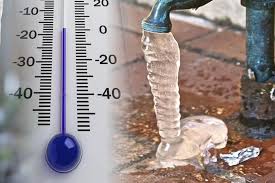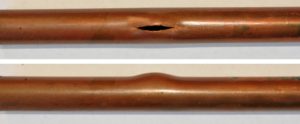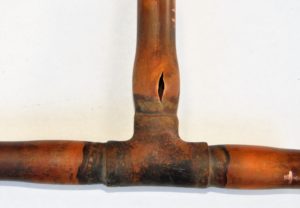
Each winter many building suffer loss of their water supply due to freezing or burst pipes but plumbers and builders can take some simple steps to avoid the resultant damage, costs and inconvenience.
Why do pipes burst?
When water cools it increases in density until it reaches 4°C. That is, it occupies its lowest volume at this temperature. As the temperature falls below 4°C, the density of water starts to decrease, and the volume increases.
Right at the point of freezing (0°C at normal atmospheric pressure) the volume suddenly increases by about 10%.
If water in a section of pipe is enclosed in some way, by valves or plugs of ice, particularly at bends where the ice plug can’t slide along the pipe, the increase in volume at freezing point can result in hydrostatic pressures greater than the tubes bursting point.
Smaller diameter pipe will lose heat more easily than larger diameter pipes and freeze more easily. However, all sizes can freeze given extreme conditions.
For 12.7 mm and 19.05 mm type B copper tubes the calculated bursting pressures are 26,450 kPa and 19,850 kPa respectively. This is 13 to 17 times the maximum hydrostatic test pressure of 1,500 kPa allowable in the Australian Standard, or about 30 times a fairly high domestic water pressure of about 700 kPa.
Copper pipes in the annealed condition, and areas near a brazed joint, have a higher elongation or are more ductile than ‘as drawn’ temper pipes. The softer pipe may therefore expand to take up the increased volume during freezing and may, in practice, survive several freezing. However, it has been found that in most instances the expansion forces developed in the water on freezing have resulted in a burst at the softened area near a brazed joint.
A copper pipe in the ‘as drawn’ temper has been found to have expanded from 12.7 mm to 13.7 mm in diameter after freezing, finally bursting at one point. This represents a volume increase of 17 percent and as the result of several freezing.
A test on an annealed temper copper tube 12.7 mm water pipe filled with water and sealed at each end, showed that, on exposure to below freezing conditions, has been frozen up to 6 times before bursting and a similar test on a hard drawn 50 mm tube froze 11 times before bursting.
What is required when installing new pipe work?
AS/NZS 3500.1 Water Services require that in areas where the ambient temperature regularly falls below 0°C, care shall be taken to reduce the likelihood of water services being damaged by water freezing. Where the ceiling or walls are insulated the water pipes should be located on the heated side of the insulation.
In cold climates, it requires that all pipes located outside building be either buried at least 300mm below the surface or insulated in a prescribed manner. There are also regulations regarding insulation of pipes inside a building including in an unheated roof spaces within 100mm of the roof covering and within 20mm of an external wall.
In cold climates where it is not possible to protect the water pipes from the cold, there is a recommended thickness of either foam nitrile rubber or flexible polyethylene foam insulation as set out in the table below.
| Pipe Size (DN) | Insulation Thickness (mm) |
| 15 | 14 |
| 18 | 9 |
| 20 | 6 |
| 25 | 4 |
| 32 | 3 |
The insulation thicknesses were calculated using the equations given in BS 5422 to just prevent freezing of water initially at 15°C if exposed to an ambient temperature of −5°C for a period of 8 hours.
If conditions are particularly severe over an extended time, additional thicknesses of insulation may be necessary to prevent water freezing. In some circumstances, when a service is not in use in very cold areas, it may be advisable to turn the water off at the main and drain the pipe system, particularly if adequate protection against freezing has not been provided.
Other Services
Do not forget the other water services. Fire hydrant services covered by AS 2419.1 are required to be protected from freezing and sprinkler systems covered by AS 2118.1 allow for the use of dry systems and inclusion of tail-end anti-freeze systems where necessary. Wet sprinkler systems shall not be installed in premises where there is danger, at any time, of the water in the pipes freezing.

Example of 12.7mm burst copper pipe

Example of a 19.05mm burst copper tube
*This article has been reproduced with permission from Plumbing Connection Magazine, AUTUMN 2022.
Lanella Media does not endorse any manufacturer, product or service nor does it provide any assurances of product or service performance.